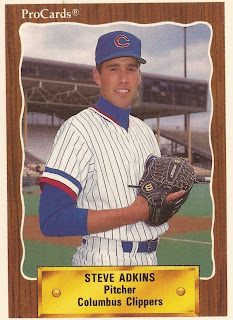 |
| The 1994 Montreal Expos honored before the March 29, 2014 exhibition game at Olympic Stadium. (G21D Photo) |
Part 1: Expos Found | Part 2: Honoring 1994
Part 3: Expos Speak | 2012: Expos Search
The big number on Saturday in Montreal was 50,229. That was the attendance at the Blue Jays-Mets exhibition game at Olympic Stadium.
The big number for me, though, was 12. That's the number of players or coaches in the building who have been featured here. There were also three others who are to be featured here in the future.
All of the former 1994 Expos took part in the pre-game ceremony to honor the team that was the best in baseball that year.
The players were each called out on the field one by one, greeted by Youppi! The crowd greeted them as champions.
 |
| 1990 Phoenix Firebird Gil Heredia, center, and 1990 Omaha Royal Tim Spehr, right. (G21D Photo) |
The cool thing about that list is it shows where that 1994 Expos team came from. My focus is the 1990 season, where players were that year. I then figured out what happened to their careers.
Four years before they would help the best team in the game, all 11 were in the minors. Also, only two of the 11 were actually with the Expos system then, Cordero and Felipe Alou. Tied with the Expos was the Dodgers system, with both Scott and Fletcher at AAA Albuquerque.
They all came together, with some other pretty good players like Larry Walker, Marquis Grissom and Pedro Martinez. Then, for a brief time, they were all on top of baseball.(Martinez also played for Great Falls in 1990)
 |
| A close-up shot of the gathering of 1994 Expos. Darrin Fletcher is standing with the beard. Tim Scott is standing far right. Felipe Alou is standing far left. (G21D Photo) |
In addition to the former Expos players, there were also four managers or coaches, two each with the Blue Jays and the Mets. With the Blue Jays, there was manager John Gibbons and first base coach Tim Leiper. With the Mets, there was manager Terry Collins and pitching coach Dan Warthen.
That all brings the total of players in the place to 15. I also got some cool pictures, if I ever get to interview any of them for the site.
 |
| Blue Jays first base coach Tim Leiper, right. (G21D Photo) |
Sean Berry and Lou Frazier introduced at Olympic Stadium
1994 Montreal Expos Featured
-Moises Alou: Played for the 1990 Harrisburg Senators.
-Sean Berry: Played for the 1990 Memphis Chicks
-Wil Cordero: Played for the 1990 Jacksonville Expos
-Darrin Fletcher: Played for the 1990 Albuquerque Dukes
-Lou Frazier: Played for the 1990 London Tigers
-Gil Heredia: Played for the 1990 Phoenix Firebirds
-Tim Scott: Played for the 1990 Albuquerque Dukes
-Tim Spehr: Played for the 1990 Omaha Royals
To be featured in the future
-Joey Eischen: Played for the 1990 Gastonia Rangers
-Denis Boucher: Played for the 1990 Dunedin Blue Jays
-Felipe Alou. Managed high-A West Palm Beach in 1990
Wil Cordero and Moises Alou introduced at Olympic Stadium
2014 Toronto Blue Jays
John Gibbons, Blue Jays manager: Played for the 1990 Scranton Red Barons
Tim Leiper, first base coach: Played for the 1990 London Tigers with Frazier
2014 New York Mets
Terry Collins, Mets manager: Managed the 1990 Buffalo Bisons
Dan Warthen, pitching coach: Pitching coach with 1990 Calgary Cannons
After the ceremony: Let's Go Expos
Olympic Stadium
Part 1: Expos Found | Part 2: Honoring 1994
Part 3: Expos Speak | 2012: Expos Search























